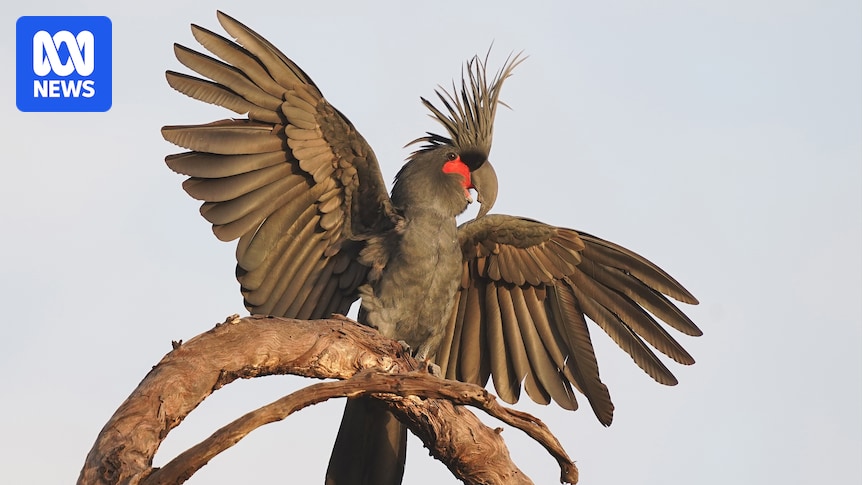Few birds have nesting requirements as finicky as the endangered palm cockatoo, which is facing its own housing crisis.
With a long slender crest and vibrant red cheeks, the smoky grey-black bird, which is renowned for its unique drumming abilities, is Australia’s largest parrot.
“Palmies” nest in tree hollows in the woodlands of Queensland’s northern Cape York Peninsula.
But it can take more than 250 years for trees to grow large enough to accommodate the birds, which grow up to 60 centimetres long.
The hollows are slowly carved out by termites or fungi over several decades and can only be accessed after a cyclone breaks off the top of the tree.
Palm cockatoos need old-growth trees such as large eucalypts to accommodate their size. (Supplied: Christina Zdenek)
With the cockatoo’s habitat under further threat from land clearing and wildfires, conservation charity People For Wildlife is working with an ecologist and traditional owners to build more homes for the birds.
It is trialling three types of nests on Apudthama Country near the tip of Cape York, including wooden hollows carved from fallen trees and modular nest boxes made from resin.
Executive director Daniel Natusch said the group was also enhancing existing hollows with the help of an arborist.
“We’re … essentially speeding up the hollow-creation process, so widening these hollows and getting rid of the termite mud,” he said.
The group plans to introduce about 30 hollows and monitor them over several years.
The trial involves installing artificial nests made of wood or resin and enhancing existing hollows. (Supplied: People For Wildlife)
Birds ‘nervous’ but ‘curious’
Palm cockatoos have one of the lowest breeding success rates of any parrot species and lay just one egg every two years, contributing to their estimated numbers dwindling to fewer than 2,000 in Australia.
Dr Natusch said the cockatoos had yet to nest in one of the new hollows this breeding season (August to January), but had shown signs of interest, including dropping sticks into the cavity.
“They’re curious but probably nervous at the start … We’ll have more information hopefully come December,” he said.
“Once we know what they really like in terms of their housing, we’ll be better placed to begin doubling down and creating that vital real estate for them.”
‘Like ducks to water’
Man-made nests have proved successful for another endangered cockatoo.
Cylindrical nesting boxes known as “cockatubes” have proliferated around Western Australia over the past 15 years since the state’s environment department promoted their use to conserve species, including Carnaby’s black cockatoo.
More than 1,000 “cockatubes” are thought to have been installed across WA. (Supplied: Eddy Wajon)
Former wildlife officer Rick Dawson looks after about 400 tubes across the state’s south-west and described them as a “cockatoo Club Med”.
“Once we started putting up the artificial hollows, the birds pretty much took to it like ducks to water,” Mr Dawson said.
He first installed a “cockatube” at a Carnaby’s cockatoo breeding area at Coomallo Creek in the Wheatbelt in 2011.
He said the site was now home to more than 80 artificial hollows and 70 restored nests.
“There were 41 nesting attempts [clutches of eggs] in 2009 at Coomallo and, a year or so ago, we got them to 147,” he said.
Loading…Long-term monitoring plans
Dr Natusch said the Cape York project also involved building fire breaks around nests and using cameras and sound recorders to monitor the birds.
“The percentage of successful fledglings, or young birds, that come out of these hollows is low, relative to many other bird species, and no-one really knows why,” he said.
“We want to find out, are these animals getting eaten by goannas? Are they flooding? Are they getting burned in fires? What is happening to the young birds? Are they accidentally being killed by the parents?
“We don’t really know, and so, with that information in hand, we’ll be able to make better decisions.”
The project is one of five recipients of an Australian Geographic Society Award For Nature.

